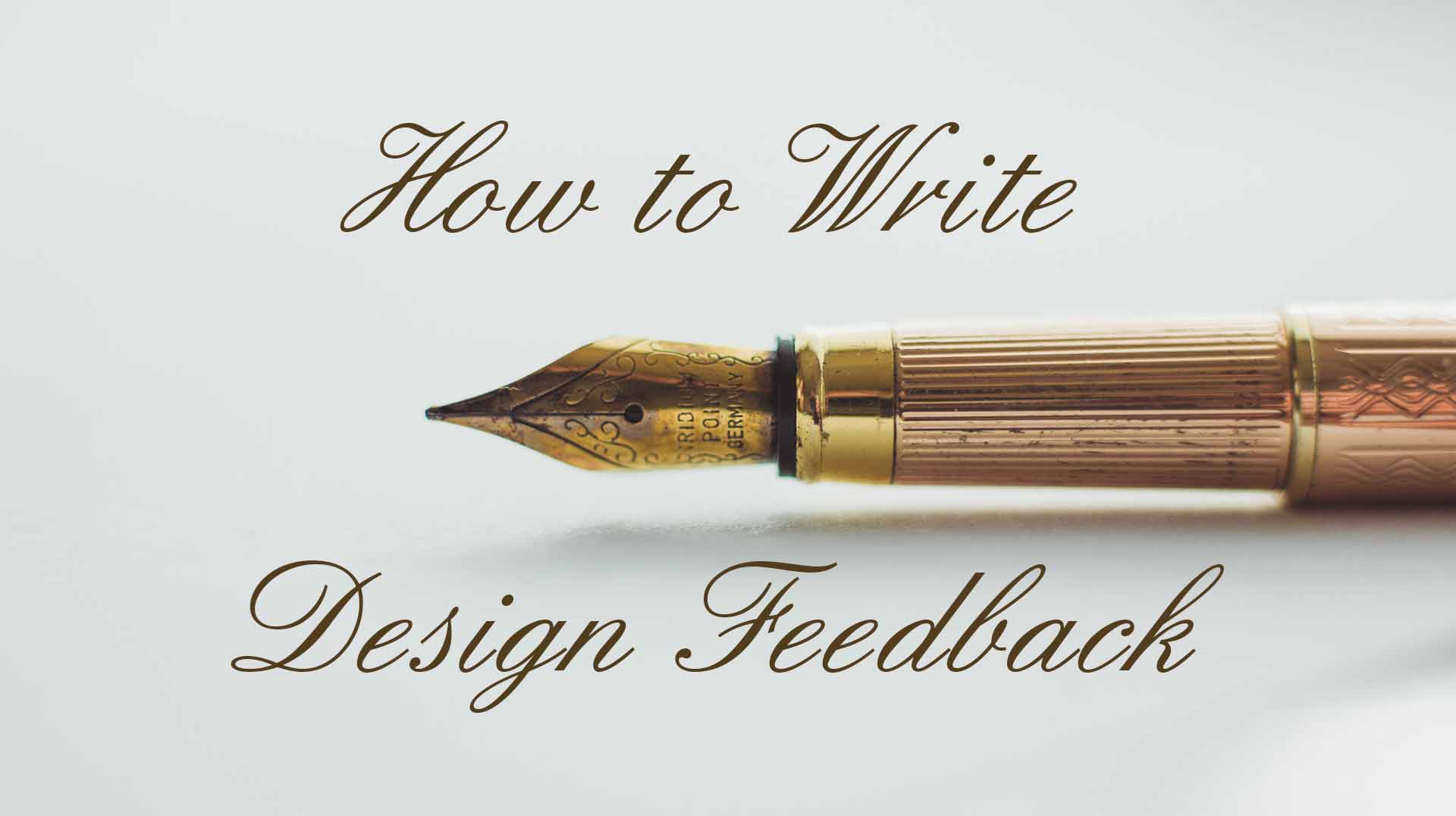Let me start this topic with a story from real life. I’m sure, you’ve had the similar situation as well.
Table of contents:
Intro in design feedback problem
When driving the car with my wife sitting next to me, on one of the crossroads she says I need to turn right, but at the same very moment, she points left with her hand. Of course, listening to her in this situation is a mistake, and I really need to understand that she meant left, despite she says the opposite. Now, imagine the situation when I’m driving a car with my wife not sitting next to me, but following her directions over the phone: “And turn right, when you see the store with a squirrel on its signboard.” This time, I don’t know that she means left and I turn right, as she said. The situations are very typical, but what are the consequences of this mistake?
First of all, I lose time. I lose time to understand that I’m moving in the wrong direction. I lose time to understand where I made a mistake. I lose time to get back on track. What if I stuck in a traffic jam? More time wasted. Another consequence is me losing money. I lose a few cents for extra fuel I need to waste for extra miles I drive. But what if I’m in a hurry for the plane, and due to that mistake, I miss my flight? I lose more money. And if it’s an important business trip, where I need to sign the contract? I miss the flight, I miss the meeting, I’m losing a contract, I’m losing money. Due to one wrong turn. Of course, I’m angry. I’m angry at my wife for telling me the wrong direction and I’m angry at myself for asking her to tell me the way to the airport. That might result in the serious quarrel and who knows how this affects our marriage in the future.
You probably have already understood what I’m talking about it in terms of design feedbacks, but let’s talk about the consequences of a poor one.
What’s the price of bad design feedback?
Many clients think that to give and get design feedback is easy, but this is totally wrong. Actually, writing design feedback is a stepping stone for many marketers, and it has its own subtle nuances and tricks that have to be considered. A good actionable feedback may save the project while the bad one can destroy even the best idea ever. Imagine that you are design agency client. You might think that your client feedback process is close to ideal and your explanations are clear and understandable. They probably are… to you, but not other people.
If a designer or his manager got you wrong, you would definitely receive the project later than it was planned. Lost time = lost money. And what if the deadline of the project is here, but you are not even halfway there? Who is to blame? A creative agency, who did not understand what you mean or you, who was not able to explain everything properly? What are your further steps?
Even if you prove that the problem was on the agency’s side what it gives to you? You can ask for a discount, not to pay money for extra steps that needs to be done to get back on track, but would it cover your expenses if your project’s is totally behind the schedule?
Of course, you can lay off this creative agency and find another team to start working with them. Finding a good creative agency takes time – you keep on losing money. Even if the project is not on fire, and you can afford to start fresh, are you sure that the same situation will not happen again? Are you sure that this time you will definitely understand each other? The initial problem is still not resolved. It was not even addressed.
The key problem here, that clients, sometimes, do not understand that they need to put some efforts to write a decent useful feedback, that this is their responsibility to make sure that the design team knows what needs to be done. And vice versa, the design team should not accept the visual feedback until they are one hundred percent sure what the client wants to say in their design review.
So, we have outlined the problem – vague feedback causes lost time\money for both – the creative team and their client.
Let’s focus on the problem solution now and think how to get design approval from client.
How to give effective feedback?

As every workflow part in the project, communication and giving quality feedback is built on certain key rules that aim to make communication as clear and effective as possible. Let’s take a closer look at some of them.
Personal tastes do not matter
Surely everyone has different preferences, but in such things as design and marketing they should be packed in a chest, barred with a lock, and put aside to the farthest corner you can find in your attic. When you tell your designer: “Well, I don’t really like it cuz it’s not my taste”, you are making things worse for yourself only. Yes, not everyone likes pop-art, minimalistic style, or whatever your designer decided to use for your project. But you have to accept that some things are more popular than the others and will surely do better in a certain marketing campaign. If you like Renaissance architecture style, it does not mean it will work perfectly for a bar or a club. You should try to check with the specialists what works better in your business segment, it might happen that the things you personally don’t like the creative work the best in the sphere you are working in. Plus, “I don’t like” – doesn’t give any details. You don’t like colors? You don’t like fonts? Maybe the whole idea looks silly for you? What exactly you want to change and why? Remember, “I don’t like it” is not an answer.
Business comes first
So, we’ve established that satisfaction with your personal tastes or needs is a bad way to go. How to assess the mockup, then? The way is quite simple. Your judgment should be based on what will be beneficial for your project, what will make it more interesting and likable. When you prepare valuable feedback and come up with the ideas for edits, ask yourself: how will this help to improve the design work? Why is this edit necessary? If the answer is: “because I like it better this way” – come back to the previous point and read it again, attentively. If you can explain your choice and proof that your ideas are beneficial – time to explain it to your designer.
As every workflow part in the project, communication and giving helpful feedback is built on certain key rules that aim to make communication as clear and effective as possible. Let’s take a closer look at some of them.
The more questions you ask, the better
Sometimes you can find yourself in a situation when you cannot explain why you don’t like your designer’s work. It might be not a matter of taste or some logical reasoning – you simply don’t know. You have two ways here. First one: go tell your designer to change everything without any explanation and be ready that they get really mad with you. Second one: ask them to explain their decisions. Why did they choose this font? How will these colors benefit the artwork? Why did they place the logo here but not there? If you are working with professionals, they will gladly explain that to you, and you might find the final product design not that bad. Or come up with some valid edit suggestions. Either way, you get +1 to your karma bag for your curiosity and desire to understand the logic behind the decisions.
“You know nothing, Jon Snow”
Why do you hire a designer? Probably, because you cannot create a good design on your own. You should keep that in mind when you have a feedback session. Never ever try teaching people how to do their jobs – they know how to hit your target audience by using different tactics. We are all better than someone else in certain areas and worse than them in the others. Always be respectful and patient, and people you work with will do the same to you.
Time is money and sometimes even more
Do not put off everything till the last minute. It’s a good idea to pre-arrange schedule and deadlines not only for designers but for all stakeholders including yourself. When the whole workflow is organized and planned in advance, you won’t find yourself in a situation when you give feedback and suggest edits two days before release. Schedule all meetings in advance, make sure the time and dates suit everyone. Such preparation might save you lots of money and nerve cells. Sure, scientists now say that they can restore themselves but it’s much better not to check it!
Everything is in one place
E-mail communication is a pain in the neck for any project that needs proofing. We won’t discuss it once again here, you can just check one of our articles dedicated to this topic. But it’s a good thing to remember that all communication and all the feedback should be kept in one place so that you don’t waste time looking for it in different sources, email chains, or social media chats. Proofing soft is a better solution here. You will never miss or lose anything, it’s convenient and helps to keep everything clear and precise.
The Structure of Design Feedback
The structure of the design feedback you give may vary depending on the design type you are working with. Here we go with our four essential types:

Web design and UI design
Since you are working with a website or application, it is crucial that your positive feedback concentrates on functionality. The first question to pay attention to – is everything clear and understandable? Remember: a good user interface design is the one that does not need a manual and user experience is the top priority. The second – is everything working as expected? Are there any bugs or errors? After you are done with these questions, you can assess the looks.
Architecture design
When it comes to architecture, you should understand that the chosen style must serve the purpose of the design and match the specific design critique requirements of a particular project. Remember our example about Renaissance bar? Keep that point in mind to avoid such inappropriateness. Your interior and exterior should match – they cannot seem like parts of two different buildings. Regardless of the purpose of your design, you must pay attention to the use of space. Is it used efficiently? Is everything arranged conveniently enough?
Branding and package
Probably, the most problematic niche in legal terms, especially if you are making a medicine package. Different countries have different regulations of what should and should not be on the package, which might be considered inappropriate or even simply banned. Even the size of the design elements might matter. You have to adapt to it, especially if you have a product to sell worldwide. The first question to ask is: “Is there anything that violates any laws?” The second one should consider production. If package design makes its production problematic, it should be changed. Then go the color choice, logo placement, and etc.
Graphic design
Advertisements and printing materials should also be considered from a legal point of view. But then, the most important thing they should rely on is, again, serving its purpose. The purpose of the ad is being catchy and attracting attention. Recently I saw somewhere a pizzeria ad with a picture of pizza cut in slices of different shape and form. Is that a usual way we cut pizza? No. Does that catch people’s eye? Yes, definitely – it’s so successful that it’s a Reddit meme now. Everything can be perfect in the ad – colors, tones, placement, but if it doesn’t attract people’s attention, it’s just one more mundane and boring billboard that will be quickly forgotten.
Design proofing tools
Let’s go back to the story I started this article with – why would I ask my wife to tell me the route to the airport if smart people invented GPS for me? The same goes for design feedbacks.
A funny thing: the very notion of design feedback goes back deeply to the ancient times of cavemen. Just imagine, someone was supposed to decorate the chief’s tent following his preferences. “Make our mammoths on the wall seem bigger and stronger than the mammoths on the other chief’s wall,” he said. It is specific feedback as well. Done, the mammoths are bigger, but now the leader decided that this color would not fit and asks to change it. Let’s say that this is the next version and the stage of corrections.
As we can see, the design feedback appeared many centuries ago. Fortunately, we have enough tools for proofing today, and the review process is much more automated and convenient. They cost a lot but really become a panacea. Before you pick your proofing tool, it is important to understand that different apps will suit different needs and types of design better than the others. For example:
- Graphic, branding, and packaging design: Approval Studio, Dropbox, Notable, etc.
- Architecure design: Approval Studio, GoVisually, Cageapp, Mural, FileCamp, etc.
- UI/UX design: Approval Studio, GoProof, Proofhub, Proof HQ, ProofMe, etc.
A word about our creation – Approval Studio. Our primary business goal was to make it as easy and as fast as possible. All the functions that were available only for big companies are now available for freelancers and creative agencies. We created a software that will be convenient for different users from different niches with different needs:
- Branding design
- Packaging design
- Printing design
- Graphic design
- Architecture design
- Interior design
Approval Studio is designed for feedbacks to be discussed quickly and efficiently; it will allow you to come to an agreement with client or designer. It saves an immense amount of time. And, as you remember, time is money! And sometimes even more.
How to give feedback to designers? Approval Studio asked experts
As you probably know, we actively communicate with designers from all around the world and ask their opinions on the hottest topics in the industry. Recently, we asked them about their personal experiences in terms of how to give design feedback, and here’s what they say:
Cyndi Hunter,
Head of Marketing at Tybot Laboratories Inc.

I am a client who has worked with many designers and have learned that setting clear expectations is CRUCIAL. As best as you can, clearly articulate your vision, so that they can invest time producing results that they know are in line with your needs. Designers also must explain the fees upfront for revisions to keep clients from expecting hours of free work outside of the scope of the project.
Clients: giving a designer a vague description of a project puts undue pressure on them if you (the client) actually have a strong opinion about how things should look. “Trusting” a designer to somehow read your mind, and somehow channel a vision you have and bring it to life is unfair, if you haven’t provided them with a detailed description. This inevitably leads to clients demanding full revisions from a designer who has already completed the bulk of the work as well as a potentially-awkward conversation about increasing the budget.
If you are in need of design help, be very clear about what you want (even provide a rough sketch), and discuss your needs with the designer beforehand. After you’ve done this, have them relay back to you what they’ve heard. This will help to eliminate misunderstandings and confirm that they understand your vision.
If you are open to honest feedback, then I encourage you to ask for their honest opinion — if they disagree with your vision, hear them out! Designers know what is effective in their trade, and can help to steer you the right direction.
If you tell them that trust them to do things their way, but in the end, you aren’t happy with it, remember that you must pay for their time for the work they have done, as well as pay for more hours if you want changes. This is not a ‘pay once’ scenario with endless hours of work until you receive what you like.
Ingrid Salinas Enciso,
Project Manager at MRM // McCann

I think to provide effective feedback you need to set clear requirements so that the “product” or final design could fulfill them. The feedback needs to be objective, and you need to be open-minded and learn to understand what the creative team wanted to show with the design they provided.
Alex Kotovskov,
Head Of Design at Rentberry and Floorl

Well, I think there’s no right way. It always depends on the client, and you need to know them first. What is the client’s background, expectations, understanding of the design and development process? Then you can choose the right process and tools specifically for this client. So be prepared for any situation is a key to success.
In my experience the main things that worked for almost any type of client were:
- Having a dedicated person to communicate with the client
- Explaining the further process and agreeing on that
- Using some kind familiar services like InVision or dropbox for demonstration
- And in the recent time Figma becomes a killer, because of transparency and speed
Clare Chambers,
Direct & Performance Marketer | SME, Examiner & Trainer for Leading Marketing Qualifications

I find that the most important thing to work effectively with clients is clear communication from the outset. That is to say a clear understanding of their expectations and their needs. However, I would still be aiming to overdeliver on whatever was promised to ensure their satisfaction. Finally, I think having empathy and patience with people – two massively lacking things in today’s society – really helps to achieve great results.
Charlie Harding,
CEO of Let’s Roam

To give good design feedback, you have to first understand your goals and business objectives. Work with your team to discover what you’re trying to accomplish. Once you have that it’s a lot easier for your team to build something that you’ll love and will help your business grow. If you don’t like a design element, it’s important to give the why behind your decisions so your team can start acting even more independently.
Conclusion
I hope this article fully answers such questions as “why design feedback is so important?”. It is what moves the project forward and becomes essentially the final destination for the artwork you’re preparing for the client. If the feedback is positive, of course 🙂
What is your personal experience of giving design feedback? How do you make it effective? Share your ideas with us, we will be glad to hear from you! And stay tuned: in our next article we will take a designer’s point of view and will figure out the questions you should ask your client to get constructive feedback.
Thanks to all those people helping us to write this material. Traditionally, we are waiting for you to share your experience and your opinion on the topic. Contact us via email or simply add comments below. And, of course, sign up for Approval Studio – one of the newest design feedback tools for designers. We currently offer a free 6-month-long Pro plan for influencers, so let us know if you’re interested!

 TEAM SOLUTIONS
TEAM SOLUTIONS WORKFLOW SOLUTIONS
WORKFLOW SOLUTIONS



 REVIEW TOOL
REVIEW TOOL PROJECT MANAGEMENT
PROJECT MANAGEMENT TOOLS & INTEGRATIONS
TOOLS & INTEGRATIONS
 CLIENT INTERVIEWS
CLIENT INTERVIEWS









